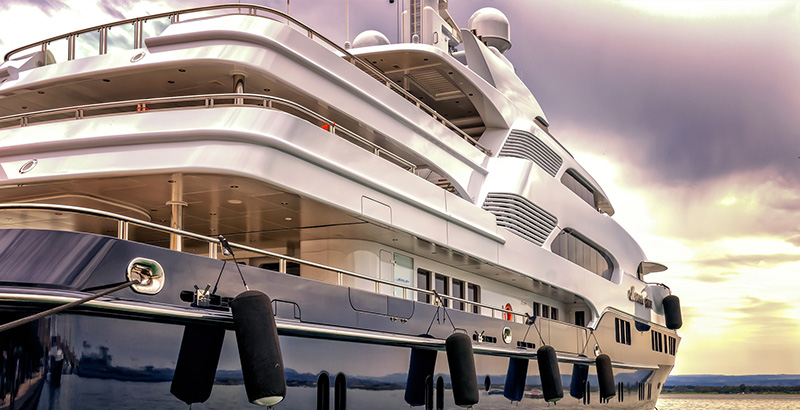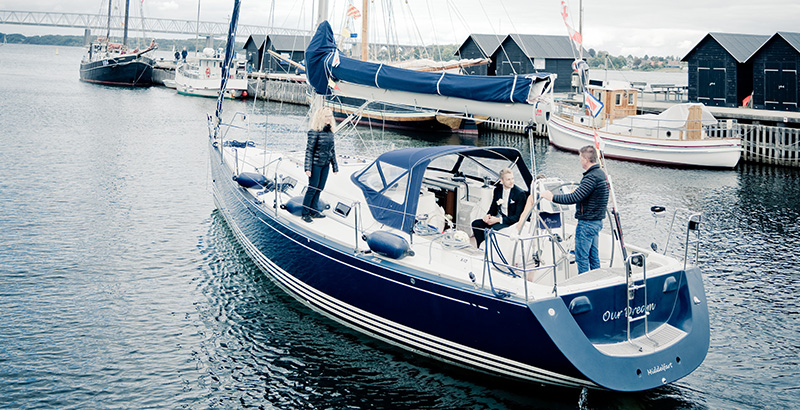We use cookies, along with some third-party sites (like Google, Facebook, etc.). By continuing to visit this site you agree to our use of cookies.


- Search Yachts
- Destinations
- Company
- Sailing info
- Blog
Need help? Contact us
Boat propellers work like airplane propellers, but instead of air, they move through the water. The main difference between a boat and an airplane is that the boat stays horizontal while the plane goes up and down as it moves forward.
A ship's engine turns a shaft that starts at the bottom of the boat. A big gear called a propeller thrust bearing connects to each side of the shaft so that half of the gear sits inside the hull and half outside. Inside this gear is a smaller gear with blades attached to it. These blades are shaped almost exactly like airplane propeller blades, except they face backward on a ship because there is no lift force pushing them upward, so they need to push water behind them instead of pulling it in front of them.
The gears on a ship are all different sizes based on how much power the engine has and the size of the propellers it needs to move. On smaller ships, these gears can be very large, while some bigger ships have two or even three big gearboxes in a row, each with dozens of little gears inside that all fit together into one huge transmission for moving the propellers.
Even though boat propellers look just like airplane propellers, they work completely differently underwater than airplanes do in the air. Boats stay horizontal and move forward by pushing against water underneath them. In contrast, planes stay up vertically by pulling against air over them and never actually touch their bottoms against anything. The only force boats and planes share is inertia. Propellers can also harness that force that makes it hard to start or stop moving to help push the boat forward.
The airplane propeller works because air has a lot of inertia, so it takes very high speeds for an airplane to get enough force from its propellers to pull it up into the sky. But water only weighs 8 pounds per gallon, which doesn't sound like much but is 800 times less than air! This means that even slow boats tend to have much higher inertia in the water than planes do in the air, which helps them move easily through their medium.

To calculate how fast a boat must go to overcome the friction of the water against its hull and move forward, you need to measure the density of the water and the hull, both of which are always changing. For example, boats move faster in saltwater than in freshwater because saltwater is denser, creating more resistance against the boat's hull.
Boats have to overcome many more forces pushing them sideways or backward than planes do when they fly through the air, including surface tension between liquid molecules that cause tiny amounts of friction. Surface tension is why bugs can walk on water without sinking into it - their feet are too small for us to see with our eyes but are large enough that they spread out across many liquid molecules through capillary action, letting them stay dry even while standing in a puddle!
-An engine gearbox will be much larger on a cargo ship than on a small fishing boat.
-The faster the boat moves, the bigger its propeller(s) need to be. For example, some racing boats have propellers that are more than twenty feet across!
-The waves that boats create as they move through water can cause forces called "resonance" that are dangerous for some ships if they move too fast. For instance, if you look at videos of ocean liners, you might notice that they always seem to rock back and forth in long arcs instead of side to side or up and down as smaller vessels do. That's because ocean liners don't want their noses to dip into the waves too much. After all, that would slow them down at sea and cause dangerous resonance, so they only let their sterns bob up and down while rocking back and forth.
-The more moving parts a boat has (especially propellers), the higher the risk of breakage during use, which is why some ships have counter-rotating propellers. Instead of both propellers turning in sync with each other, one turns clockwise, and one turns counterclockwise to balance out each other's forces.
-Before leaving port, all ships check that everything around the hull is waterproof. Sometimes called "mating" or "christening," it involves putting a boat into the water and seeing whether it leaks. If so, the crew must find where it's leaking and fix it ASAP!
-Boats need to be given an oil change every few months if they move through salty water because saltwater will rust out metal parts much more quickly than freshwater. The more salt in the water, the faster their engine needs to be oiled up again. This can be done manually by collecting dirty motor oil with buckets on deck or letting some of it drip back into storage tanks underneath while engines are still running.
-If a boat's propeller or hull gets damaged from colliding with rocks or reefs, it must be either patched up on the spot or towed back to port for repairs. To keep going as fast as possible before it has been fixed, ships will often have spare "drogues" on board - special parachutes that slow down a boat quickly without having to turn its propellers against it.

-Steam: A steam engine uses heat to boil water into high-pressure gas until it becomes hot enough to push a piston out of its cylinder and turn the boat's propeller. It requires less fuel than other engines but is heavy and hard for ships to steer because their propellers kick up waves as they go forward. Steam engines were common during the early 1800s and were mostly replaced by gasoline and diesel engines (see below).
-Diesel: Most cargo ships, cruise liners, and military vessels use diesel engines because they're simple – all you need is an air compressor – and efficient; they can produce more power with less fuel than gasoline or steam engines. Diesel fuel has only been around since the early 1900s, which is much less time than gasoline has been in use!
-Gasoline: The air gets mixed with gas in a gasoline engine and then ignited into a fireball that pushes a piston out of its cylinder. Unlike diesel engines, gasoline ones must be started up using an electric motor to spin their propellers until their cylinders have enough pressure inside them to get going by themselves. Gasoline engines are used for smaller boats because they need more fuel to produce the same power as diesel or steam engines. Gasoline engine cars typically only take 4-10 minutes for this startup process, while diesel can usually go from cold to moving in under one minute.
-Electric: An electric boat doesn't have an engine at all! A battery powers a motor that in turn moves a propeller, just like one in a hybrid car. This kind of motor typically needs to be plugged in to charge its batteries every day when it's not being used, so it will have enough power to move the next time it is started up. Electric boats are usually small because battery technology hasn't advanced far enough yet for massive ones, but they're great for running around on rivers or lakes, where their quiet motors won't scare away fish
-Screw: A screw boat (or "screw-propelled" boat) has no internal engine; instead, it turns either side-to-side or front-to-back using two symmetrical propellers close to the front and back of its body. This kind of boat is usually faster than a paddleboat (with one big propeller in the center) but not as fast as a hydrofoil (which uses wings instead).
Eva Tucker writer for Volvo Penta.
Sailing Routes: 7-Day Dalmatian Sailing Itinerary
Marin @Danielis - November 21, 2017.
5 House Rules You Should Follow Onboard While Sailing
Marin @Danielis - May 19, 2017.
Top Places to Go Snorkeling in Croatia
Marin @Danielis - February 16, 2017.
5 Reasons Why Sailing Is The Best Way To Travel
Marin @Danielis - July 25, 2017.
10 Tips on how to prepare for a Sailing Holiday in Croatia
Marin @Danielis - November 07, 2017.